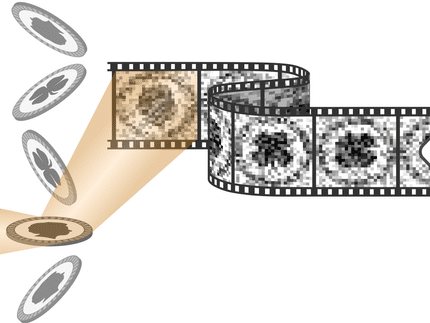The dark side of transmission X-ray microscopy
Researchers develop a novel method to make scattered light usable for X-ray imaging in the nanometer range
X-ray microscopes are essential for examining components and materials because they can be used to detect changes and details in the material. Until now, however, it has been difficult to detect small cracks or tiny inclusions in the images. By developing a new method, researchers at the Helmholtz-Zentrum Hereon are now able to visualize such changes in the nanometer regime. In particular materials research and quality assurance will profit from this development.

3D representation of the gold structure based on the dark field images (left) and the attenuation images (right). The dark field images make it easy to recognize irregularities in the inner structure (marked with orange arrows) that would otherwise remain hidden.
Hereon/ Sami Wirtensohn
The quality must be right. This also applies to materials science. When metal parts are welded together, you need to know whether the weld seam is any good - or whether small cracks or pores have formed inside, which could lead to failure. High-performance materials, e.g. for electrodes in electric car batteries or fuel cells, should not contain defects to allow the current to flow undisturbed.
In order to better understand the effects of changes in materials and to detect possible defects, X-rays have already been used for a long time to visualize defects in materials. In conventional X-ray images, structures are made visible through the attenuation of X-rays. However, this is often not sufficient to detect very small or low-density structures.
Combining imaging with scattering
Hereon researchers Sami Wirtensohn and Dr Silja Flenner from Dr Imke Greving's group have now succeeded in making such small structures visible in the nanometer range, using a new method. Unlike a conventional X-ray image, they do not use the attenuated light itself, but rather the light scattered by the object being X-rayed, which is deflected in different directions. “Nanometer-sized structures such as tiny cracks scatter the light - and this scattering can be seen,” explains Sami Wirtensohn, first author of the study. This makes details and structures visible that are normally difficult or impossible to see. The special feature: “The method can even make structures visible that are below the resolution of the X-ray microscope,” explains Silja Flenner, who initiated the project.
The challenge with the new approach was that the researchers had to suppress the attenuated light of the object to a certain extent so that the scattering image would become visible. In X-ray microscopy, they therefore use optics that redirect the X-ray light so that the rays follow a known pattern. These X-ray beams can then be blocked by installing apertures. The scattered light, on the other hand, changes its direction when penetrating the sample and can pass by the apertures. This results in the so-called dark field image, for the first time with nanometer resolution. “This gives us an image in which the nanostructures are very clearly visible due to the scattering,” says Sami Wirtensohn.
Little effort, big impact
For materials research, this is a gain with little effort. “For the first time, a practical method for dark-field imaging is available that can be easily implemented in an X-ray microscope,” says Imke Greving, who is leading the X-ray microscopy team at the Hereon imaging beamline P05 at the Deutsches Elektronen Synchrotron (DESY). Such X-ray microscopes are operated at large synchrotron facilities, so-called particle accelerators, of which there are only a few dozen worldwide. These could easily be retrofitted with an aperture to enable dark-field microscopy. This would be worthwhile because companies or materials researchers would be able to search for tiny defects and flaws in materials much better in future. The team around Sami Wirtensohn has now reported on their new development in the scientific journal Optica.
Original publication
Other news from the department science

Get the chemical industry in your inbox
By submitting this form you agree that LUMITOS AG will send you the newsletter(s) selected above by email. Your data will not be passed on to third parties. Your data will be stored and processed in accordance with our data protection regulations. LUMITOS may contact you by email for the purpose of advertising or market and opinion surveys. You can revoke your consent at any time without giving reasons to LUMITOS AG, Ernst-Augustin-Str. 2, 12489 Berlin, Germany or by e-mail at revoke@lumitos.com with effect for the future. In addition, each email contains a link to unsubscribe from the corresponding newsletter.




























































